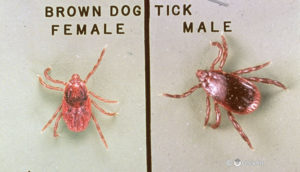Welcome to AgriLife Research Network. This is your first post. Edit or delete it, then start blogging!
The Guardian Way – April 2021
AgriLife LGD Program Update
By: Bill Costanzo, Texas A&M AgriLife Research
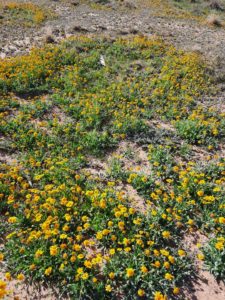
Spring is here and flowers are blooming in the pastures. It’s almost time for the second round of puppies in the bonding project to leave the Center and move on to our research ranches and a cooperating producer’s ranch. Hopefully you had a chance to check out Dr. Zoran’s very informative webinar on LGD nutrition on March 25. If you missed the live event, you can view it on our YouTube channel Texas A&M AgriLife Livestock Guardian Dog Program – YouTube. Our next webinar will be held on May 20 at 3pm. That webinar will discuss legal issues facing producers using LGDs. You can register for the event on our Facebook page or on the AgriLife Centers website under the events section.
This month we will start a three-part series on internal parasites presented by our guest writer. Dr. Meriam Saleh, Ph.D., from the Texas A&M Department of Veterinary Pathobiology at the College of Veterinary Medicine and Biomedical Sciences. Dr. Saleh recently moved from Oklahoma State University and has be a guest presenter twice for the AgriLife LGD Programs bimonthly webinars.
Guest Article: Common intestinal parasites of livestock guardian dogs, part 1 of 3
Dogs, including livestock guardian dogs, can become infected with a variety of parasites. Most people are familiar with ticks and fleas, which are types of ectoparasites (meaning external parasites) that we can see on the skin of our dogs (and sometimes even people), but people are less familiar with endoparasites (meaning living inside the host) of dogs. The most common endoparasites infecting dogs include hookworms, roundworms, and whipworms. Dogs become infected with these parasites a few different ways, but a common theme among all three of these worms is that once infected the dog’s environment also becomes contaminated by the parasite which can lead to greater infections or reinfection after treatment, which is why it is important to treat parasitic infections in a timely fashion and in consultation with your veterinarian. The best parasite treatment is actually prevention, and the Companion Animal Parasite Council recommends that every dog be administered year-round broad-spectrum parasite control that is effective against heartworm, intestinal parasites, fleas, and ticks—with particular attention to controlling parasites that are zoonotic, meaning they infect people too.
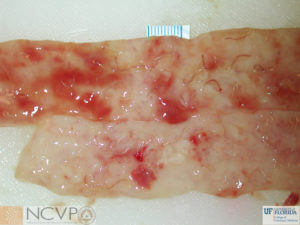
Hookworms, roundworms, and whipworms fall into the category of intestinal parasites and there are a variety of routine preventive products available to treat and control these infections. Ask your veterinarian what they recommend; there is not one best parasite control product as it depends on your dog’s history, lifestyle, and the type of product you want to administer plus a variety of other factors. It is also very important that pregnant and nursing dams are maintained on broad-spectrum parasite control products as some parasites can pass to the puppies in utero or when the puppies nurse. It is better for the health of the puppies to prevent infections from ever occurring whenever possible.
I mentioned earlier that hookworms, roundworms, and whipworms can all contaminate the environment of an infected dog creating potential for reinfection or an even greater worm burden for the already infected dog. Let’s take a closer look at how dogs acquire these parasites. In this first post, we will look at hookworms.
Hookworms live in the small intestine of the dog, where they attach to the intestinal lining and suck blood from the host (Image 1). Hookworms are voracious blood feeders and can cause significant anemia and even death in severely affected puppies. Hookworm infections may also cause diarrhea and some weight loss. In addition to feeding on blood hookworms’ mate and lay eggs in the small intestine. Hookworm females shed a large number of eggs every single day—these eggs are then passed in the feces when the dog defecates (Image 2). Once in the environment the eggs will begin to develop forming a larva inside, eventually the larva will hatch out of the egg and further develop until it reaches the third stage, which we call an L3. This L3 then infects a host (either the same or another dog, or sometimes people depending on the exact species, more on that later)

when it is ingested or when it penetrates the skin.
After the L3 is either ingested or penetrates the skin of the dog it will migrate in the tissue to arrive in the small intestine. Some of the migrating worms may stay in the tissue and become arrested, which means they pause their development, while the rest go on to the small intestine and become adults that suck blood, mate, and lay eggs. These arrested larval worms can reactive or resume their development and go on to the small intestine at a later time, or in the case of a pregnant dam may reactive and move to the mammary tissue to infect nursing puppies via the milk. These worms make their way to the small intestine of the puppies and the life cycle repeats itself.
I mentioned earlier that sometimes that infective L3 stage in the environment can infect people too. Again, it depends on the specific hookworm species, but Ancylostoma braziliense, which occurs in warm coastal areas of the United States as well as Central and South America, and Ancylostoma caninum, which is the most common hookworm of dogs in the United States both can and do infect people. The L3 stage can penetrate the skin of people too and can use something called cutaneous larva migrans (CLM), which is when the larvae migrate in the skin and cause red winding tracks that are very itchy. Most cases of CLM are diagnosed in the southeastern and Gulf Coast areas of the United States. An easy way to avoid larval penetration of the skin is to be sure to wear shoes. CLM is easily treatable but does cause mild discomfort when infected.
You can see how quickly an infection can lead to a contaminated environment and even more infective parasite stages to keep the infection going, which is why routine use of preventive products is so important, particularly for a zoonotic parasite like hookworm. For more information on these and other parasites you can check out the Companion Animal Parasite Council and their Pets and Parasites website (https://www.petsandparasites.org). In the next post we will talk about the roundworms and last whipworms.
Written by: Meriam N. Saleh, Ph.D., is a Post-Doctoral Research Associate at the Texas A&M Department of Veterinary Pathobiology, College of Veterinary Medicine & Biomedical Sciences. Dr. Saleh currently serves as the project leader for the National Center for Veterinary Parasitology. In 2019 she completed a two-year postdoctoral fellowship focused on ticks, their geographic disruption, and tick-borne diseases at Oklahoma State University. She earned a BS in Animal Science from the University of Tennessee in 2011 and a Ph.D. in Veterinary Parasitology from Virginia Tech in 2017. She is also an active member of the American Association of Veterinary Parasitologists.
LGD Puppy Bonding Project


Several of the puppies discovered our resident porcupine last month. Lenny, Laverne, Squiggy and Louise have all had quills in them as of the end of March. Laverne ended up going to the vet for a couple that we were unable to remove at the Center. Hopefully the other three pups don’t find out about the porcupine. The current round of puppies will be getting spayed and neutered this month. They are all 8-9 months old and will be leaving the Center for our ranches and a cooperating producer’s ranch in May. It’s important to get your LGDs spayed or neutered before their first heat cycle to decrease the chances they may roam looking for a mate.
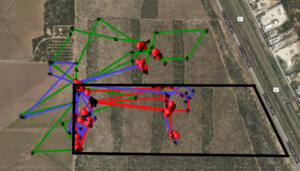
The puppies bonded in hot wire pens (Laverne, Lenny, Squiggy and Wyatt) are staying in their pasture. Laverne and Lenny left once due to a large hole in the fence but have not wandered out of the pasture again once it was fixed. The other three pups (Doc, Thelma and Louise), as seen in the picture above, bonded without hot wire have been leaving their pasture on a regular basis. Doc and Louise have left it a few times to check out the nannies and new kids in the pasture next to them. Thelma, however, has been leaving almost daily from her pasture to visit LGD Thor, the nannies and kids. We placed Thelma in the kennel for a few days as punishment to see if it would change her behavior.
Thor has been roaming much less since he has been at the Center. He has not left his pasture since late February. The nannies Thor is

guarding are all kidding at this point, so he is staying pretty close to them now. Thor even refused to leave the area of a dead kid for 2 days until we finally found it and took it away. He seems to be doing well now that he is with a couple hundred meat goats. Sometimes you need to keep moving a dog until it finds the type of animals its comfortable guarding. Thor and his siblings stayed closer to the goats they were bonded with than the sheep when they were released from the bonding pens.

We had some issues with Waylon playing rough with young lambs last month. We placed a drag on him for a few days and then released him again. He was still playing with them, so we decided to move him to a set of older ewe lambs and dry older ewes until he gets older and calms down. Waylon is very playful still at 13 months of age. Most LGDs don’t mature until at least 18 months of age. Waylon has several more months to go before we can give him more responsibilities and completely trust him on his own with livestock. He rarely follows the feed truck now so hopefully we have moved past that issue with him. He is still very friendly and easily caught in the field anytime I need to catch him.
Johnny has been doing well at our ranch in Menard. It appears that separating the brothers in November of 2020 was a good idea. He has not roamed off the ranch property since the separation. Below is a picture of Johnny’s travels for 1 month. He is staying predominately with the Dorper sheep which is what he was bonded with. He has been seen with our meat goats at times, but it looks like he is guarding the livestock we need him to guard. The sheep are staying on the West side of the ranch which is where Johnny is spending most of his time based on the GPS tracking data. Most of the ranch is open due to a multiyear research project so the livestock and LGDs can move to any location they want on the 4000 acres.
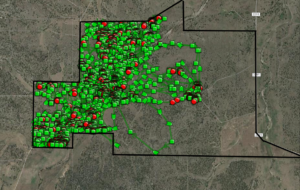
If you enjoyed my monthly blog, don’t forget to subscribe to it The Guardian Way | Texas A&M AgriLife Research and Extension Center at San Angelo (tamu.edu). To provide feedback on this article or request topics for future articles, please contact me at bill.costanzo@ag.tamu.edu or 325-657-7311. The Texas A&M AgriLife Livestock Guardian Dog Program is a cooperative effort by Texas A&M AgriLife Research and the Texas Sheep and Goat Predator Management Board. Make sure to follow us on our social media sites and share them with your friends and family!
Facebook: https://www.facebook.com/TAMUlivestockguarddog/
Instagram: @tamulivestockguarddog
YouTube: https://www.youtube.com/channel/UCF7YbP6bNDV7___6H8mifBA
Don’t forget to check out the Texas LGD Association on Facebook! Follow the organization at https://www.facebook.com/TexasLGDAssociation
The Guardian Way – March 2021
Program Update
Do not forget to register for our LGD Nutrition and Feeding webinar on March 25th at 3pm with Dr. Deb Zoran, DVM, of the Texas A&M Small Animal Clinical Science Department. You can register for the free event on our Facebook page at https://www.facebook.com/TAMUlivestockguarddog/ . Look under the Events section and use the link in the webinar description to register for the Zoom event. If you are not on Facebook, you can also register for the webinar on the San Angelo AgriLife Center Events page. https://sanangelo.tamu.edu/events/
As always, stay tuned to our social media channels for educational videos, tips of the week, fun photos, and more. Do not hesitate to reach out to us with questions, comments, and concerns.

We are trying out a new radio frequency identification (FID) door on a feeding station to keep out varmints from the feeder. We have not encountered any issues with the pups using it at the AgriLife Center. They adapted to the door very easily and can enter the feeding station when needed. Each of the puppies wears a RFID tag attached to their collars. We had some initial issues with the dogs losing the tags, but after using zip ties to attach them we solved that issue. The door can be programed for up to five different dogs and has a proximity sensor that can be adjusted out to ten feet away. It uses four D-cell batteries as a power source. The door can be completely locked, left open or set to open with the RFID tags. We have purchased an additional door for testing at one of our research ranches. We will keep you updated on the progress of this project.
We received a lot of messages and emails regarding LGDs and the harsh winter storm that covered Texas during the middle of February. Your LGD does not need any special treatment that you would not provide for your livestock. Shelter, bedding, and supplemental feed are welcomed by your LGD as much as your livestock. These types of dogs have thick double hair coats on their bodies and extra hair between their toes for a reason, to withstand cold winters. All of the LGD breeds were bred for thousands of years in Europe to endure the harsh environment there. The weather in Europe routinely gets very cold with snow and ice in most of the regions. However, if during any storm, your LGD is shivering, just as with livestock, they need shelter and warm bedding immediately. My own LGD refused to be taken into shelter even on the coldest nights of the storm. He was perfectly happy with a nice pile of bedding in the backyard, watching over the generator and keeping any cats or squirrels away that were looking for some place warm to hideout.
LGD Puppy Bonding Project
All of the puppies in the current phase of the bonding project have been released from their 1-acre pens into larger pastures with their charges and are doing well. The seven puppies will stay at the Center until they are 8 months of age. At that point, the pups will be spayed/neutered and placed at a cooperating producer’s ranch along with our research ranches.

The Legends of Country Music are turning a year old this month, and both are doing well. Johnny has not roamed out of his pastures since being separated from Waylon. It seems that separating Johnny and Waylon worked out well for both dogs. Waylon is still following the feed truck from time to time and needs corrective behavior when he does, but it is becoming less often as time goes on. Other than following the feed truck, Waylon does not roam out of his pasture. Hopefully, Waylon and Johnny continue to work well and graduate from the Bonding Project in September of this year.
The Superheroes and the Three Stooges are all graduating from the Bonding Project this month. All the pups are now 18 months of age. They will no longer be tracked as part of the project. I recently visited the Stooges to change out tracking batteries and all of the dogs looked well and were easily caught with the sheep. Larry is still very friendly while Moe is a little less than he was previously. Curly is still shy, but quickly remembered me after a few belly scratches.

Looking back, there were some challenges with Superheroes Hulk and Thor roaming at the Center as puppies. Hulk and Goliath have never left the research ranch in Ozona since being placed there in March of 2020. Hulk does wander between the wool sheep with Goliath and our Angora goats protected by an older male, Max, from time to time. Our best guess is that he goes to provide extra protection to either species when needed.
Thor is continuing to roam as an adult. Thor was doing well here at the Center but decided to roam over to ASU in early February. We then placed him in the kennel for 4 days as punishment for his roaming. He was very happy to get back to his goats after that and as of late February he has not roamed again.
To provide feedback on this article or request topics for future articles, please contact me at bill.costanzo@ag.tamu.edu or 325-657-7311. The Texas A&M AgriLife Livestock Guardian Dog Program is a cooperative effort by Texas A&M AgriLife Research and the Texas Sheep and Goat Predator Management Board.
Follow us on Facebook: https://www.facebook.com/TAMUlivestockguarddog/
Follow us on Instagram: @tamulivestockguarddog
Follow us on YouTube: https://www.youtube.com/channel/UCF7YbP6bNDV7___6H8mifBA
The Guardian Way February 2021
Starting with this issue of The Guardian Way, we have streamlined it to allow for quicker reading of project updates and events going on with the Texas A&M AgriLife LGD Program.
Program Update
We will be presenting webinars on various topics related to LGDs this year every other month. Our first webinar for 2021 was presented by Dr. Saleh, formerly of Oklahoma State, but now working at Texas A&M University. The topic was “Common LGD Parasites and How to Control Them”. We thank Dr. Saleh for her continued support of the Texas A&M AgriLife LGD Program. The next webinar in March which will be on LGD nutrition and the May webinar will be on LGDs legalities and producers’ rights. We hope you will join us for these upcoming webinars. You can register for the free events on our Facebook https://www.facebook.com/TAMUlivestockguarddog/ . Look under the Events section and use the link in the webinar description to register for the Zoom event. If you are not on Facebook, you can also register for the webinars on the San Angelo AgriLife Center Events page. https://sanangelo.tamu.edu/events/
As always, stay tuned to our social media channels for educational videos, tips of the week, fun photos, and more. And don’t hesitate to reach out to us with questions, comments, and concerns.
LGD Puppy Bonding Project
If you are not a long-time reader, we’d like to review the LGD bonding project. In the late summer of 2019, we started a bonding project with weaned livestock guardian dog puppies. We started with six puppies that were placed as singles or as pairs in bonding pens with and without hot wire. We started our second complete set of eight pups in September of 2020. Newly weaned LGD pups are sourced from local breeders and they all start out in a 60×60 pen for one month with sheep and goats. Then we open the gate and allow them access to a 1-acre pen for three months. The two bonding pens are about ¼ mile apart and they are in the same 100 acre pasture. We have two more bonding pens in another 100-acre pasture that is ½ mile away. We have added a fifth bonding pen for this round that is near our headquarters, to determine if pups are more likely to roam back to the bonding location as adults.
Once the puppies reach six months of age, they are released with their charges into a 100-acre pasture and tracked until they are eight months of age. Notably, the bonding pens are new fence that prevent them from escaping and the 100-acre pastures have decent fencing, but they can be breached if the LGD has a strong desire to leave. At that time, they are spayed/neutered and some of the dogs are placed at cooperating producer’s ranches for further observation until they are 18 months of age. The rest of the dogs are placed on our research ranches for observation. At 18 months of age the dogs have “graduated” from the program. Our first round of pups are closing in on that 18-month mark soon. We will give you an update on the outcome of the Stooges and Superheroes by the late spring.

Since our last blog, we haven’t had any other issues with stock or puppies being attacked at the Center so hopefully the event with Shirley and the goat was an isolated incident. All the dogs at the Center made it through the mid-month snowstorm in January and they seemed to enjoy it. The TV show pups (Laverne, Lenny and Squiggy) were released from their bonding pens into a 100-acre pasture with their stock in mid-January and are all doing well. The dogs and a few livestock are wearing GPS trackers so that we can monitor their movements and patterns for the next two months. In mid-February the other set of pups, Doc, Wyatt, Thelma, and Louise will all be released into a large pasture at the Center with their charges. They will also be monitored with GPS trackers.
The Legends of Country Music, Johnny and Waylon, are doing well after we separated them to new locations. Johnny has been staying with stock and has been floating between sheep and goats in Menard. Waylon has been at the Center guarding some Rambouillet ewes that will be lambing soon. He randomly wanders from the pasture when the feed truck comes through, but it’s not every time. We haven’t figured out why that truck is such an attraction to him compared to other vehicles that he sees and doesn’t follow. We are trying different methods to discourage this behavior from positive to negative reinforcement. Neither seem to work for very long. We will keep you updated on their prog

ress next month.
The Superheroes are all doing well. Goliath and Hulk are doing a great job guarding stock in Ozona. As a reminder, Thor was in Ozona and had to be moved to Menard due to roaming. Unfortunately, he roamed in Menard and had to be removed from there as well. He is now at the Center in San Angelo for further observation and behavior correction. We placed him in a kennel for two weeks as punishment and then released him back with stock. We placed him with a yearling meat goat herd in San Angelo to see if he will stick to his charges and stop roaming; so far it has been working. Check back with us in March to track Thor’s progress.
To provide feedback on this article or request topics for future articles, please contact me at bill.costanzo@ag.tamu.edu or 325-657-7311. The Texas A&M AgriLife Livestock Guardian Dog Program is a cooperative effort by Texas A&M AgriLife Research and the Texas Sheep and Goat Predator Management Board.
Follow us on Facebook: https://www.facebook.com/TAMUlivestockguarddog/
Follow us on Instagram: @tamulivestockguarddog
Follow us on YouTube: https://www.youtube.com/channel/UCF7YbP6bNDV7___6H8mifBA
The Guardian Way – January 2021
Home & Work
Hopefully 2021 will prove to be a better year than 2020! I had some changes in my personal life as I know many did, some caused by Covid-19. I know I am happy for the new year to be here, sadly we are all still being affected by Covid-19 however. But with the vaccine available soon, hopefully life will return to normal in 2021.
The boys are back in college again and looking forward to their new courses. We got some projects done in December at the new house and the dogs seem to be slowly adjusting to their new surroundings. Life is definitely better living in the country though. For those that do, don’t ever take it for granted!
The Predator Board has extended the contract for an LGD Research Specialist for another two years so that we can continue to provide support for producers using LGDs. We will continue research on bonding LGDs, producer outreach and our social media platforms. We will be focusing more on outreach moving forward than research so that more educational information is produced and can be presented to producers on LGDs.
When Should You Spay/Neuter?
I often get asked by producers when they should spay or neuter their LGD or if they should at all. There is some debate on how soon this should or shouldn’t be done. We suggest that you and your veterinarian work this out, as there are pros and cons to every decision. Whether or not you should spay or neuter your LGD is a little easier to answer. Unless you are planning on breeding your LGD, then we recommend that you spay/neuter them.
Most LGD breeders would agree that the breeding instincts in LGDs is quite strong. One reason dogs may roam is because they are in heat or looking for a female to mate with. To help curb this, it’s important to spay/neuter them. Having an unwanted or unexpected litter of pups in your pasture may cause more problems than it is worth. First, your female will require more feed to nurse the pups. Second, she will be pulled away from guarding your stock during the time she is caring for and raising her pups. If pups are raised in the field without human socialization, they may become feral and be extremely difficult to handle. They may also spread disease and parasites to other LGDs if they

are not properly cared for.
To get a more in-depth perspective on the topic of spaying and neutering, I spoke with Dr. Debra Zoran DVM, PhD, DACVIM-SAIM, Texas A&M Veterinary Emergency Team member and Professor of Medicine at the Texas A&M College of Veterinary Medicine and Biomedical Sciences. Here is what Dr. Zoran had to say on this subject:
“This is a great question and with many medical decisions. There is not an absolute right or wrong answer. However, let me give you some things to consider. We do know that in medium to large breed dogs the risk for early closure of their epiphyses (the parts of the bone that allows growth in length as the dog grows) when dogs are spayed or neutered before they reach full adult size: that means about 12-15 months in medium (20-40 lb. dogs) and 18-24 month in larger breed dogs (40lb or greater). So, for example with my search and rescue dogs, we try very hard to keep them intact until they are 18 months of age (if we can) to allow this bone development. The reason that early epiphysis closure is a problem is that it can lead to changes in joint confirmation (hips or elbows) that can increase the risk of poor joint structure that results in risk of arthritis (hip dysplasia or elbow dysplasia) from the conformation changes. Obviously, there are also genetic and dietary factors here, but early age spay/neuter is a proven risk factor now. So, we recommend that dogs that are intended for work (sporting, hunting, working dogs such as search and rescue) not be spayed or neutered as long as possible (12-18 months is ideal, longer if they are giant breeds dogs) – to reduce this risk and increase working life longevity from reducing joint issues).”
Next, I asked Dr. Zoran about spaying/neutering working LGDs and if it was a good idea to help control roaming and fighting. “Yes, you are correct that the risks of intact dogs (male and female) mating, running off, and fighting are real, and they must be managed by how you handle them. If you are not able to control those things by how you use them or work them during those early years (8-18 months) then it is definitely better to have them spayed or neutered early. In the search and rescue world, most of these dogs are kenneled when they are not training or working, so the problem can be mitigated, but in a herding situation, that may not be an option and if not, then you have your answer. Another aspect of the decision is male/female – obviously the females coming into heat will affect their work, as well as disrupt work in the males, so some groups will spay the females a bit earlier (1 yr.) but hold the males a bit longer 15-18 months (then neuter) as they are typically larger – this is a compromise that often happens just because of the logistics of managing them – not saying it’s better, but just what happens.
In my opinion as a veterinarian, and I advise canine handlers and trainers about this all the time – it is our responsibility to do the right thing and prevent unwanted mating if we are going to choose to keep them intact during that first 12-18 months. I encourage the delay in neutering/spaying for working dogs, but you can’t just make that decision and then not take the measures necessary to prevent the other issues that occur (pregnancy in very young bitches, males running and fighting). I think the main thing to remember is this: if you can’t manage the issues that will occur with intact dogs because of how they are housed, trained or whatever, then it is far better to have them spayed or neutered early.
As I said, there is no right or wrong answer here, but there are definitely consequences to any decisions you do make.”
Source: Debra L. Zoran, DVM, PhD, DACVIM-SAIM, Professor of Medicine, Texas A&M Veterinary Emergency Team (VET), FEMA IST Veterinarian, Texas A&M Task Force 1 Urban Search & Rescue Department of Small Animal Clinical Sciences, College of Veterinary Medicine and Biomedical Sciences Texas A&M University, College Station, TX 77843-4474, dzoran@cvm.tamu.edu, (979) 845-2351
LGD Puppy Bonding Project
We had some sad news last month in early December. Over a weekend, Shirley and one of the goats in her bonding pen at the Center were attacked and mortally wounded. Our veterinarian suspects the attack was a large domestic dog. We suspect some dogs from a nearby neighborhood, as the only LGDs we have at this ranch are very friendly to people, livestock, and other LGDs. Shirley was only 5 months old. Wyatt (just under 4 months old) and half a dozen other livestock in the pen were not injured during the attack. The incident happened in a bonding pen that is only a few hundred feet from our office complex and an employee’s residence. We can’t find sign of how the culprit gained access to the pen. Regardless, we are going to make improvements to bonding pens to prevent this type of issue from occurring in the
future. Shirley was a great pup with a lot of potential. She will be missed in the bonding project.

All the other seven puppies in the 2020 bonding project are doing well and growing fast. Doc is still the largest of his siblings and Laverne is
the largest of her siblings. The puppies have bonded well to the animals in their pens. Recently the “Laverne and Shirley” pups had stock switched so that the dogs do not develop too strong a bond to specific animals. Doc and his siblings will have their stock changed by the time you read this blog. We swapped dogs to different pens regularly so that they bond to species and not specific animals. While there isn’t research to prove switching livestock promotes a more well-rounded bond to all livestock, we find that it is not that difficult to switch out animals and is cheap insurance to prevent a potential issue.
Johnny and Thor were doing well at the ranch in Menard for a couple weeks and were staying with their charges. Recently they roamed off the ranch again and ended up at a neighbor’s ranch. We suspect that they decided to follow a hunter’s truck this time as the fence crew was finished with the project. Luckily the dogs had GPS trackers on, and we were alerted to them leaving. Johnny returned on his own to our ranch, but Thor had to be picked up from our neighbors’ ranch.

As a reminder, Waylon had the same issue as Thor and Johnny a few months ago. Waylon was moved to the AgriLife Center in San Angelo and placed with a group of ewes that did not have another LGD. We are pleased that he has not roamed and has stayed with his sheep. He has followed the feed truck a few times, but some loud blasts of sound from an airhorn have stopped that from reoccurring. It seems like splitting up the brothers was a good choice for these siblings. Unfortunately, we were short on LGDs that would stay with the sheep at the Menard ranch and we suspect a significant amount of predation occurred on our fall lambing flock. We recently had a helicopter with hunters fly the ranch and they killed 72 hogs and 3 adult coyotes. We are planning to reinstate this method of aerial predator control to our overall predator control plan in addition to the LGDs. All the pastures at the ranch have been opened up for a long-term research project. By allowing stock to roam freely across the ranch, they are spread too thin for the dogs to adequately protect each small group of ewes. Providing aerial control of predators, should allow our lambing percentage to increase again to its previous rate of 120% at the ranch. Stay tuned to “The Guardian Way” for an in-depth discussion of this issue and how we are working through it.
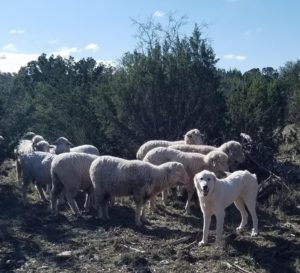
Goliath and Hulk are doing well at the ranch in Ozona. Goliath was bonded as a single dog in the bonding project without hot wire and has not left his charges to date. Hulk was bonded as a pair with Thor without hot wire in his bonding pen. He regularly moves between the sheep and goats at the ranch but has only left the ranch boundaries once which was in December. We are not sure why he left, but he has been returned thanks to GPS tracking. GPS trackers can a good investment in technology that can save you money should your LGD roam off your property. However, they do require a fair bit of work to keep them working. Most require cell signal, but some do work off a satellite signal now. The units that we use cost about $120 with a $10-$15 monthly fee. Battery life can be an issue with the cellular units, but satellite solar trackers are now available for an additional cost. Feel free to contact us with any questions at the AgriLife Center in San Angelo.
Breeder/Producer Profile
This month’s breeder and producer using LGDs is Bob Rieck from Junction, Texas.
Q. Please describe your ranch.
a. How many LGDs do you currently own?
b. Explain your LGD program.
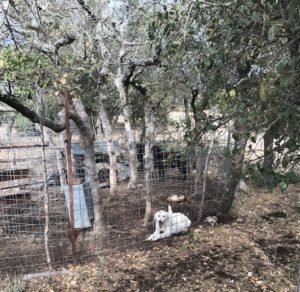
A. I have run around 6 to 8 LGDs amongst sheep and goats. I mainly try to breed dogs that have done a good job for me personally. What that means is that I only sell dogs that I do not need in my own operation. When I have a litter, I know how many I need and then begin to sell the extras until they are sold either as weaned pups or older bonded individuals.
Q. What got you started in breeding LGDs?
A. I got started as a result of not being able to eliminate coyotes by all other legal means. They were killing too many of my lambs and kids.
Q. How long have you bred LGDs?
A. Best I can remember, since 1990. So at least 30 years that I have been using LGDs on my ranches.
Q. What breed of LGD do you raise?
A. Right now, they are a Great Pyrenees/Anatolian/Akbash crosses. They seem to work best for me.
Q. Do you have an LGD mentor?
A. Hmmm, I did buy my first dog from Bob Buchholtz.
Q. What’s the one thing you wish you knew before starting to use LGDs?
A. Well, I suppose if I knew what the best breed or combination of breeds that consistently would produce the best LGD, I would not have
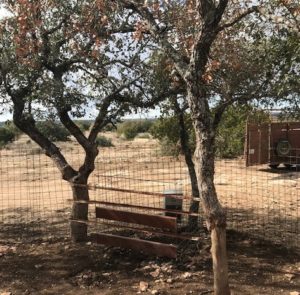
had to put so much effort analyzing why some dogs work better than others. However, this might not ever be possible because of all the variables involved.
Q. What is the number one thing you recommend to a new LGD user?
A. I would say bond the dog to the type of animal you plan to guard and leave them alone to do their job.
Q. What is your favorite LGD/LGD story and why?
A. Never really had a favorite dog. I really like any dog that does his job. As far as favorite story, I don’t know, there are so many, I could go on and on but I did have a dog once that was in a large brushy pasture that we gathered horseback and he or she (I can’t remember) would actually hide the three ewes it had been bonded to. If I found them and put them in pen and mixed them, in 20 minutes, it would have the three identically looking ewes separated in the corner of the pen standing between them and the rest of the flock and other things going on. Probably too good of a bonding job. Ha, ha. That’s a good example of why you need to rotate stock when you are bonding LGDs!
LGD Timely Tips
Every Tuesday check out our Facebook page @TAMUlivestockguardog for Tuesday’s LGD Tip of the Week!
- Proheart is an injectable 12-month heartworm preventative that is now available for your dog.
- LGD should be pure or mixed bred from guardian breeds. Purchasing a LGD that is mixed with a non LGD breed may cause problems, as other breeds tend to exhibit behavior unwanted in LGDs.
- If you are using a new LGD breeder, ask if they guarantee their dogs and what’s included in the guarantee.
To provide feedback on this article or request topics for future articles, please contact me at bill.costanzo@ag.tamu.edu or 325-657-7311. The Texas A&M AgriLife Livestock Guardian Dog Program is a cooperative effort by Texas A&M AgriLife Research and the Texas Sheep and Goat Predator Management Board.
Follow us on Facebook: https://www.facebook.com/TAMUlivestockguarddog/
Follow us on Instagram: @tamulivestockguarddog
Follow us on YouTube: https://www.youtube.com/channel/UCF7YbP6bNDV7___6H8mifBA
The Guardian Way – December 2020
Home & Work
Merry Christmas! The boys are out of college for the semester and helping me with projects around the house. New appliances are a welcome addition for us this month. Painting a few rooms and a bathroom update is on the list this month during the winter break.
It’s important to take advantage of the slower days during the winter to take care of projects that are needing your attention such as repairing dog feeders or feeding stations. You may want to provide a higher quality dog food, as your dogs will be burning more calories to stay warm during the cooler days and nights. Typically, dog food with animal protein listed as the first and/or second ingredient can maximize the nutrient level for your LGD.
With hunting season under way, it’s important to remind hunters about your LGDs on the ranch, especially if you have new or young LGDs. Remind hunters how you want them to interact with your LGDs, if they come into contact. That way the LGDs don’t end up lingering around hunting camp or worse a hunting blind. If possible, move dogs and stock to pastures with limited hunting. If problems arise, it might be best to pen up your LGDs when hunting activity is at its peak on your property. It keeps your hunters happy and keeps your dogs from learning bad behaviors such as coming to headquarters for treats or following vehicles.
LGD Puppy Bonding Project

All the puppies in the current round of the bonding project are doing great and growing fast. All the pups have been placed into 1-acre pens now with their charges. They will be in the 1-acre pens until they are 6 months of age. At that point, GPS trackers will be placed on all the dogs and stock from the bonding pens. Dogs and stock will be released into larger pastures and tracked for 2 months. Once the pups are 8 months old, we will place half of them at our research ranches for tracking and at cooperating producer ranches. The pups will continue to be tracked until they are 18 months of age.
Our second round of pups from the bonding project, the Legends of Country Music, were placed at our research ranch in Menard to help our older dog Miley guard the Dorper ewes who are lambing. After about a week at the ranch, Waylon and Johnny started to roam, even though they had never roamed at the AgriLife Research and Extension Center in San Angelo and were bonded in pens with hot wire. At first, they left their charges and joined the dogs with the meat goats. However, after about two weeks they left the ranch completely and ended up at a neighbor’s ranch approximately 2 miles from our research ranch. They were retrieved twice, and each time dropped back off with the Dorper ewes. After they left a third time and we decided to bring them back to the Center. Observing the dogs at the Center, we concluded that they were following vehicles, not just randomly roaming off the ranch in Menard. We have been having new fencing installed in Menard on several pastures. We believe that the dogs started roaming because they were following the fence crews around the ranch and then continuing as they left each day.
We decided to separate Waylon and Johnny to see if it would make a difference in their behavior. Thor was also roaming at our ranch in Ozona and visiting his three friends, the Stooges. We have placed both Thor and Johnny together at the ranch in Menard and so far, neither dog has roamed again, and they are staying with their charges. Sometimes a change of location can make all the difference in how an LGD works for your operation. Waylon is also staying with his new charges at the Center and has only left his pasture once. Again, we believed that he was just following a truck that was feeding stock. Resolving this habit of following a truck is a top priority for the Legends of Country Music. Like their namesakes, they like to be “On the Road!”
The pups that are officially in the bonding project are all bonded with four different species so that they can be easily
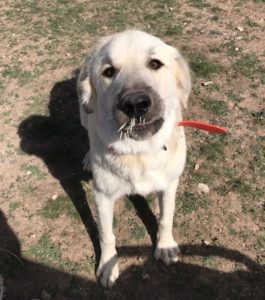
moved to guard in a new location. They are then given a quick re-bond to the new stock they will be guarding and then released on one of our research ranches or a cooperating producers ranch. However, the Legends of Country Music were only bonded to Dorper sheep which we believed would create a stronger bond. We were having predation issues on our Dorper sheep in Menard and we believed that a straight bond would ensure the dogs staying with the hair sheep. However, the dogs still ended up leaving their charges and stayed with the meat goats and four other dogs. Bonding to a specific species does not guarantee that your LGDs will stay with that species as we believed it would!
Hulk and Goliath are doing well without Thor at the ranch in Ozona. Goliath stays with his sheep while Hulk floats between the sheep and Angoras. Goliath still hasn’t figured out what happens when you play with a porcupine, however. This is at least the fourth time he has gotten quills in his face!
LGD Breed Spotlight – Slovensky Cuvac
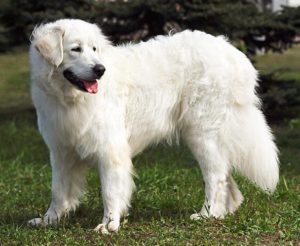
The origins of the Slovensky Cuvac breed can be traced back as far as the 17th century. It is also known as the Slovak Chuvach, and the Tatransky Cuvac. It is a large Slovakian breed known for its plush white coat and its livestock guarding abilities. The Slovensky is very similar to the Kuvasz, however the Kuvasz is a slightly larger breed of dog.
In the early years of the breed, the Cuvac was used as a livestock guardian in the mountains of the Soviet Union. As wolves began to slowly disappear from the countryside, herding practices changed and the Slovensky Cuvac breed nearly went extinct. After World War II, a veterinarian named Antonin Hruza set about to revive the breed and the first written standard was published in 1964. While rare in the United States, the dogs are making a comeback in Europe.
The Slovensky Cuvac has rather long legs and deep broad chest that makes it well suited for mountain terrain. The dogs are white as are many other LGDs from Europe. Their coat is dense and doubled with a moderate wave to it. The hair is short on the face and front of legs and longer on the body but without feathering on the tail as in other LGD breeds. The Slovensky Cuvac is a large dog that stands anywhere from 22 to 28 inches tall and weighs 70 to 100 pounds when mature.
Aa good guard and watch dog, as well as guide for shepherds, the Slovensky Cuvac has o proven its worth in the guarding of cattle and driving of poultry and other domestic animals to pasture. The Slovensky Cuvac is a powerful, calm, loyal flock guardian. It is a bold protector of its area and pack, whether it is livestock or people. These dogs have been known to be very affectionate with members of their human family but suspicious of outsiders. They are fearless guardians that will fight any intruder, even large predators like bears or wolves.
Sources: Dohner, Janet Vorwald. Farm Dogs: A Comprehensive Breed Guide to 93 Guardians, Herders, Terriers, and Other Canine Working Partners. Storey Publishing, 2016, https://www.dogbreedinfo.com/slovenskycuvac.htm , https://www.ukcdogs.com/slovac-cuvac
Breeder/Producer Profile
This month’s producer using LGDs is Shirley Pfeiffer Kilgore from New Braunfels, Texas.
Q. Please describe your ranch.
-
- What type of livestock do you have?
- How many head of stock do your dogs’ guard?
- How many acres do your dogs’ guard?
A. I am the owner of a small sheep ranch located outside of New Braunfels, approximately 1 mile from Gruene at the beginning of the Texas Hill Country. I am the third-generation sheep rancher which dates to 1939 when my family bought the ranch now known as the Historic

Pfeiffer Ranch. The ranch is approximately 250 acres with some large fields, heavy cedar, live oaks, elms, native pasture grasses, mesquites, and huisache. I currently have approximately 200 head of Rambouillet sheep with fine wool. Besides sheep I also have some cattle, horses, miniature donkeys, and a llama named Boo here on the ranch as well. Throughout the years since I was a child, I have watched more and more farm land around me being gobbled up by new house construction and businesses which in turn has crowded my ranch with more and more predators that love to prey on my sheep herd. We have coyotes, bobcats, owls, caracara, and a few mountains lions that occasionally come to visit and run through the ranch. Over the years these coyotes have caused more and more problems in even trying to maintain any kind of sheep herd worth keeping. It became such a problem that state trappers were called in to try different devices or techniques that did make some difference in the coyote population, but not enough to keep them away for very long, especially since a female coyote can have such large litters of pups. At one point not long ago, the coyotes were so bad that I was unable to even keep 1/4 of my new lamb stock that was to be sold at market for profit. At its worst, I really considered not having sheep at all anymore, but then I decided on trying Livestock Guardian Dogs to see if my success rate would go up.
Q. How long have you used LGDs?
A. After making my decision approximately 5 years ago to try Livestock Guardian Dogs to protect my sheep I have never looked back. It was

the absolute best decision I have ever made. I have never once looked back on my decision to try these dogs and regretted it. I cannot believe the 100% success rate that I have had with them. I have always loved dogs throughout my childhood. We had a variety of farm dogs, some for companionship and some dogs like the border collies that worked our herds. Of course, these dogs are very different than the Livestock Guardian Dogs that protect my livestock.
Q. How many dogs do you use?
A. I have used only two dogs during the last 5 years. My dog’s names are Aoife (Ee-fa) who is 100% Great Pyrenees and weighs approximately 130 lbs. and my 2nd dog Evanna who is 1/4 Akbash and 3/4 Great Pyrenees and weighs about 110 pounds. These dogs are siblings but from different litters and are only half related to each other by having a different dog parent on one side. Both of my dogs came when they were 6-8 weeks of age which is extremely important in the bonding process. I chose to have both of my dogs spayed when they reached 1 year of age. I waited for that period because of their large dog breed size and that time frame was also a recommendation by my veterinarian.
I am fortunate enough to work on the ranch every day. Starting out with new LGD pups 5 years ago, I wanted to come up with my own training ideas. I needed them socialized yet bonded with their charges. I did lots of reading on LGDs and decided that I would use a smaller dog pen area where my young pups would stay with their herd at night in a larger sheep pen so they were protected from harm’s way being so small at such a young age. During the day while my sheep herd would go out grazing, I decided that I would take my young pups out for approximately 2 hours to show them how important their job was going to be; I was their shepherd. We followed the sheep herd in the fields to learn sights and sounds. It was during this time I also taught my dogs not to kill the predators but to chase them away which honestly comes with their instincts as they get older. After 2 hours of training the pups it was always early afternoon. They were then put back into their dog pen area until the evenings when the sheep herd would come back in from grazing. At that time my young pups would be let out to become a part of their charges again to familiarize them and become more bonded with the sheep until it was time to be put up in their dog pen for safety during the night time hours. I did this method until they reached 8 months of age when they then went out on their own to guard. Even though this practice may be unusual, I had a great success rate in how my dogs came to be bonded with their herd.
Now that my LGDs are grown they have different jobs during the year. During lambing season my dog Aoife guards my newborns and their mommas in a smaller sheep pen area to give my newborns a chance to get on their feet. My other dog Evanna goes with the sheep herd everyday into the fields or pasture to protect the herd from predators. In the evenings all my sheep herd come in to a large fenced in area for additional protection by both dogs. After lambing season is over both my LGDs guard the entire herd during the day and night. I have had an unbelievable success rate by doing this method and the dogs do their jobs very well.

Q. Do you prefer a specific LGD breed?
A. Some producers say that there are very specific differences in all the different LGD breeds. To some degree maybe this is true, however, I believe that each breed has their own strong guarding capabilities.
In my opinion, one example of this may be the Kangal or Anatolian Shepherds that can guard against bears, wolves, or larger predators. Or perhaps using the Maremma Guard Dog breed which many say that breed of dog makes even a stronger bond with their charges and never roams. Or another example is perhaps the Great Pyrenees that guard against the coyotes, bobcats, caracara but roam more frequently over a vaster area than other LGDs may and may bark more frequently warning the predators to stay away. Or perhaps lastly the great Spanish Mastiff that can be fearless and keep away predators such as a large moose, bears, or wild boars. So having said this, I believe that all LGDs, no matter what the breed you chose and for what specific reasons you need them for, can do their jobs efficiently given what types of animals they are guarding and to what predators they are protecting against. The bottom line is as a producer you must be able to trust your breed of LGD and believe in their ability to do their job.
I spend lots of time around my animals and making sure they are cared for. Making sure my LGDs have proper food, shots, checking for burrs in their feet and coat, bathing if necessary, looking at and down their ears and checking their teeth are all necessary things I do as a producer to make sure my dogs are cared for. The bottom line here is over all maintenance is crucial to a successful LGD.
Q. Do you have an LGD mentor?
A. Over the years I have really enjoyed following a man by the name of Robert Nelson Lockey. He has a small sheep farm in Kentucky and has

quite a few LGDs, all purebred Great Pyrenees, and always has been so helpful in answering my questions that I had especially when it came to my GPs. He has been a very important asset to me starting out and learning about Livestock Guardian Dogs.
Robert has been on several social media sites through the years, and I follow his own site Great Pyrenees Adventures and Advice page. Of course, there are so many social media sites for LGDs.
Q. What’s the one thing you wish you knew before starting to use LGDs?
A. I wish I would have known that Livestock Guardian Dogs and their protection existed at all to be honest. I was not aware of LGDs and what they could do for me until about 6 years ago. We were relying on state trappers so heavily to control the coyote population here as well as other predators at that time that it was then I determined even with that type of protection it just was not enough and I needed to do something else and fast. It was in that moment that I decided that the best way of doing this was through the use of the internet and social media. After doing a lot of reading about Livestock Guardian Dogs, I wanted to immediately get started. I wanted to get started on learning what needed to be done to make this protection work for me and what breed would work best for me and my livestock. I knew it would take time since I was just starting out and starting out with 6-8-week-old pups, but I had read so much about each breed that I was very excited to begin.
Q. What is the biggest thing you would recommend a new LGD user?
A. First and foremost- Treat your LGD like the asset they are! They complete your success in raising your livestock. They can be your most valuable tool and for them to be successful, you must set them up to succeed right from the start.
There are several very important things that I do to help my GP’s success.
- Good food with protein listed first, water, and vet care.
- Microchip and tag your LGD, so they can find their way home if lost.
- Use GPS trackers. This is so important for you as the producer, knowing your dog can be found at all times and not possibly losing your dog in a snare or attacks from predators or even just wandering off where they cannot be found.
- Reinforce positive behavior. Sometimes your LGD may have a bad day, take a step aside, place your LGD back amongst its charges and make positive gestures so your LGD is successful.
A good LGD is worth its weight in gold.
Remember your LGD has a tough job! They are in all kinds of weather hot, cold, ice, snow, sleet, or rain. So, be sure to take care of your LGD.
And lastly, READ, READ, READ and ask QUESTIONS. The more useful information you have, the better you will set your LGD up for success.
LGD Timely Tips
Every Tuesday check out our Facebook page @TAMUlivestockguardog for Tuesday’s LGD Tip of the Week!
Since it’s the holiday season, I decided to add a little fun into the timely tips this month. I hope you enjoy the things that an LGD would like in their Christmas stocking and the 10 things for a Merry LGD Christmas!
LGD Stocking Stuffers
- Dehydrated mud puddle in a bag, just add water!
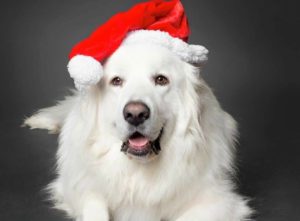
- Big bag of sticks for chewing.
- Bale of fresh hay for bedding.
- Little brother/sister that I could train to guard so I can lay in the shade all day.
- Snow, lots and lots of snow!
- A giant bag of Pupperoni Treats.
- A shedding brush.
- Large water trough with cool water for the warm days.
- Big shade tree near a water trough.
- Collar with the name and contact info of my owners.
10 Things for a Merry LGD Xmas
- Restrain them on the night of the 24th so they don’t scare off Santa and his reindeer.
- A canine calming agent so they don’t bark and wake up the kids while you are putting out the presents you just wrapped at 1a.m.
- A new package of Pupperoni treats so they come to you when you go to catch them in the field.
- A new set of batteries for your flashlight – to see what they are barking at in the night.
- New batteries in the GPS tracker so your kids can find your dog and give him/her their Xmas present.
- Phone number of the local vet on call taped to the fridge if they get into fight with a predator.
- Phone number of the local and regional animal control offices in case your LGD roams on XMAS or is picked up by a “helpful” stranger on a cold XMAS eve and taken 2 towns away.
- ID chip your dog and fill out the contact information online.
- Turn off the holiday blow ups before bed, so your dog doesn’t bark all night at them.
- A lock for the trash can so they don’t get into the leftovers after Christmas dinner.
To provide feedback on this article or request topics for future articles, please contact me at bill.costanzo@ag.tamu.edu or 325-657-7311. The Texas A&M AgriLife Livestock Guardian Dog Program is a cooperative effort by Texas A&M AgriLife Research and the Texas Sheep and Goat Predator Management Board.
Follow us on Facebook: https://www.facebook.com/TAMUlivestockguarddog/
Follow us on Instagram: @tamulivestockguarddog
Follow us on YouTube: https://www.youtube.com/channel/UCF7YbP6bNDV7___6H8mifBA
The Guardian Way – November 2020
Home & Work

I can’t believe that we are already at the end of fall with holidays right around the corner. The boys and I are looking forward to having the holidays in our new home. The dogs have adjusted well to the move and my LGD is guarding the house and yard from several roaming squirrels!
The newest set of pups for the second round of the bonding project arrived in early October and are adjusting well to their new home. These pups are out of the same parents as the Legends of Country Music. For those that follow our Facebook page, Johnny looks just like his mother and Willie looks just like his father.
The new kennel structure is finally completed and in place. It has four pens that are 6 ft x 12 ft in size. All that is left to do is install automatic waterers in the structure. It’s already been used by a few of our dogs and is a great addition to the Texas A&M AgriLife LGD program.
Internal Parasites – Gastrointestinal
This is the fifth and final part of a multi-part series on canine gastrointestinal parasites. The most common type of internal parasites that an owner of LGDs will encounter are worms. There are five main types of worms that your LGD may encounter: roundworms, hookworms, whipworms, tapeworms, and flukes. Last month we covered tapeworms and this month we will focus on flukes in LGDs to finish out the series.
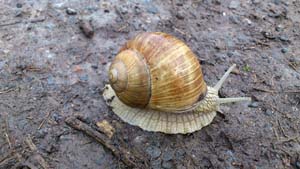
Flukes are a class of parasites that can infect dogs and many other types of animals. They have a complex life cycle that can involve multiple intermediate hosts. The typical intermediate host however is a snail. There are three main types of flukes that affect dogs: intestinal, liver and lung. All types of flukes infect dogs through an intermediate host such as mice, snails or fish.
Intestinal flukes generally do not cause illness unless there are large numbers of flukes. Heavy infections can cause intestinal inflammation in the small intestine. Several antiparasitic medications are effective against intestinal flukes. Flukes in the bile ducts and gallbladder cause mild to severe liver disease in dogs. Various species of flukes have been reported from the liver of dogs in most parts of the world. Infections are generally uncommon and mild infections may pass unnoticed. In severe infections, dogs may develop progressive weakness, ending in complete exhaustion and death in some cases.
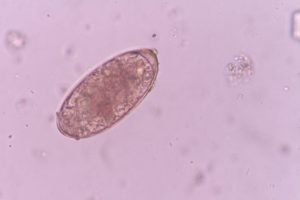
The adult lung flukes usually live in cysts, primarily in the lungs of dogs. Infection is common in North America with this type of fluke. The eggs from the adult flukes pass through the cyst wall, are coughed up, swallowed, and passed in the feces. The life cycle includes several snails as the first intermediate host and crayfish or crabs as the second. Dogs become infected by eating raw crayfish or crabs that contain the encysted parasite. The young flukes eventually migrate to the lungs where they become established. Infected animals may have a chronic, deep, intermittent cough and eventually become weak and lethargic, although many infections pass unnoticed. Several drugs provide effective treatment for lung fluke infections.
Sources: https://www.merckvetmanual.com/dog-owners/digestive-disorders-of-dogs/gastrointestinal- parasites-of-dogs?query=canine%20internal%20parasites#v3202812, https://www.merckvetmanual.com/digestive-system/gastrointestinal-parasites-of-small-animals/flukes- in-small-animals
LGD Puppy Bonding Project
Waylon and Johnny are doing well at our research ranch in Menard. They are staying with the livestock but are separating often as the sheep move to different locations on the ranch. The Superhero’s are still doing a great job for us. Thor has begun to roam to a neighboring ranch. We will be moving him to another location where he does not have friends (the Stooges) on the other side of the fence. The Stooges are all doing well, and the producer is still very happy with them.

Laverne, Shirley, Lenny and Squiggy are all doing great. They were released from the 60ft x 60ft pens in early October. They are all staying with stock and bonding well. The pair seems to be doing much better walking on a leash and being tethered than the two singles. I noticed this last fall also with the pups in pairs. The single pups in the previous round showed a slightly stronger bond to the stock than the pairs did. I believe the singles don’t want to leash walk as well because they are leaving their charges unguarded. Each time I walk Squiggy, he is always checking the location of his charges.
The four newest pups Doc, Wyatt, Thelma and Louise are adjusting well to their new home.

They arrived in mid-October and are growing fast. They will be placed in pens without hot wire to track their willingness to roam as adults. Wyatt was placed with Shirley to test whether dogs bonded close to headquarters are more likely to return to them as adults.
LGD Breed Spotlight – Polish Tatra
The Polish Tatra Sheepdog, originated in the Podhale, a small, mountainous region in southern Poland. The area sits against the Tatra range, which are the highest peaks in the Carpathians. Tatras were originally developed as a livestock guardian dog. Outside the U.S., the breed is also used for personal protection, as guard dogs for private property, military/police work, carting, and as guide dogs. Tatras generally do not attack predators but stand their ground and stay with their charges. In their home country, they serve a dual purpose and act as both a herding dog and a guardian dog.
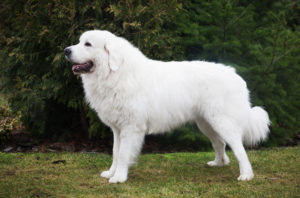
The Tatra is a strong and compactly built dog, with a rectangular body shape. Its body expresses both power and mobility. Their profuse coat is generally pure white. The hair is short and close on the head, muzzle, the front of the forelegs, and below the hock. The neck and body are covered with a long, thick, straight or slightly wavy hair that is hard to the touch. Tatras have a very thick undercoat. The thighs and tail are also covered with long, thick hair.
They are hardy, strong dogs able to work on a minimal diet and withstand cold, harsh temperatures, as well as the hot, dry heat. The Tatras require early socialization- and then throughout their entire life to remain friendly towards people. The Tatra is a large dog, often reaching 24 – 28 inches and 100 to 130 pounds. He has heavy bone, a massive body and is powerfully muscled. World War II brought the breed to the brink of extinction due to the dogs being pressed into military duty. The Polish Kennel Club worked to re-establish the Tatra Dogs following the War. The Tatra is one of the rarest dogs in North America.
Sources: Dohner, Janet Vorwald. Farm Dogs: A Comprehensive Breed Guide to 93 Guardians, Herders, Terriers, and Other Canine Working Partners. Storey Publishing, 2016, https://www.ukcdogs.com/owczarek-podhalanski, https://www.ptsca.com/
Producer Profile
This month’s LGD producer is the Giles Family from Comfort, Texas.
Q: Please describe your ranch.

- What type of livestock do you have?
- How many head of stock do your dogs guard?
- How many acres do your dogs guard?
A: We raise Angus cattle, fine wool sheep, & Angora goats. We have roughly 700 head at different times on the ranch. Our dogs do not always stay with the same herd. They move around as they see fit to cover predator threats. They guard around 2,000 acres as they move around.
Q: How long have you used LGDs?
A: We have had dogs guarding our stock for about 2 ½ years now.
Q: How many dogs do you use?
A: We have four dogs (1 dog for about 2 1/2 years and 3 dogs for 3 months)

Q: Do you prefer a specific LGD breed?
A: No, we don’t prefer a specific breed. We currently have Akbash/Great Pyrenees and Anatolian/Great Pyrenees mixes on the ranch.
Q: Do you have an LGD mentor?
A: Yes, we do. Bill Costanzo at the AgriLife Center in San Angelo and WW Livestock Guard Dogs (where all four of our dogs came from). It’s important to have someone to contact if you are having trouble with your dogs.
Q: What is the biggest thing you would recommend a new LGD user?
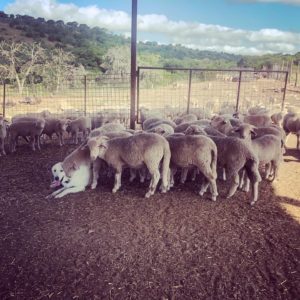
A: Our biggest recommendation is to take the necessary time it takes to bond your dog to livestock and to you. It is time consuming, but so worth it in the long run. Properly bonded dogs are much easier to control and stay with your livestock.
Q: What is your favorite LGD/LGD story and why?
A: Pepper (dog we have used the longest) stayed with a nanny that had her head stuck in the fence until we came along to get the nanny out. Once the nanny was loose, Pepper
went on. Pepper wears a GPS tracker. Noticed her tracker kept pinging in the same location on a fence line, which is how we found the nanny that was stuck. Pepper knew she couldn’t get the nanny out of the fence, but maybe she knew we’d find the nanny if she stayed with her.
LGD Timely Tips
Every Tuesday check out our Facebook page @TAMUlivestockguardog for Tuesday’s LGD Tip of the Week!
- Move your LGDs to another field when hunters are on your property to reduce problems between the dogs and hunters.
- Remind hunters not to give treats to your LGDs unless they want them to come back to their blinds for more.
- Having several good pictures of your LGD is important if they need to be identified away from your property. Make sure you have pictures of any special identifying marks.
To provide feedback on this article or request topics for future articles, please contact me at bill.costanzo@ag.tamu.edu or 325-657-7311. The Texas A&M AgriLife Livestock Guardian Dog Program is a cooperative effort by Texas A&M AgriLife Research and the Texas Sheep and Goat Predator Management Board.
Follow us on Facebook: https://www.facebook.com/TAMUlivestockguarddog/
Follow us on Instagram: @tamulivestockguarddog
Follow us on YouTube: https://www.youtube.com/channel/UCF7YbP6bNDV7 6H8mifBA
The Guardian Way – October 2020
Home & Work
Change is inevitable and how you deal with it makes the situation easy or difficult. Sometimes it’s easier to accept the change than fight it if you can.
The boys and I have settled into our new home in town and the dogs are adjusting to city noises. It is important to allow your LGD time to adjust to new situations that they encounter. If you move them to a new location or introduce new stock, make sure they bond with those animals and new surroundings. Make sure they know where feed and water are located.

Progress is continuing on the new kennel structure. We finished half of it, and we hope to have the structure completed by the end of September. Its already been used by Waylon with his injured paw. We will add more tin on the sides once the other half of the structure is in place.
The Fall LGD Field Day in Fredericksburg was cancelled, but we have scheduled monthly webinars in place of it for the foreseeable future. Our October webinar will be on LGD diseases and is scheduled for October 21. Check out our Facebook page to register for the event. @TAMUlivestockguarddog
We recently started an Instagram account also. You can follow us @tamulivestockguarddog. You can also check out past webinars on our YouTube Channel at https://www.youtube.com/channel/UCF7YbP6bNDV7___6H8mifBA
Internal Parasites – Gastrointestinal
This is the fourth part of a multi-part series on canine gastrointestinal parasites. The most common type of internal parasites that an owner of LGDs will encounter are worms. There are five main types of worms that your LGD may encounter: roundworms, hookworms, whipworms, tapeworms, and flukes. Last month we covered whipworms and this month we will focus on tapeworms in LGDs.

There are several types of tapeworms that may infect dogs. Adult tapeworms are segmented worms found in the intestines of dogs. However, they rarely cause serious disease. Most urban dogs eat prepared foods and have restricted access to natural prey and usually acquire the common tapeworm from eating fleas. Livestock guardian dogs on the other hand, have more access to various small mammals, in addition to raw meat and offal from large mammals. The possibility of exposure to several different tapeworm species can be expected in these dogs and regular deworming is required. On sheep ranges and wherever wild ungulates and wild canids are common, livestock guardian dogs may acquire the hydatid tapeworm.
Hydatids are primarily parasites of dogs, coyotes and foxes. Dogs become infected by eating offal containing hydatid cysts. These cysts have thick walls and may enclose many smaller cysts containing small tapeworm heads, giving them a sandy looking appearance. The cysts develop into adult worms once inside the gut of the dog. The adults then produce microscopic eggs with thick shells to protect them from environmental extremes. The eggs are passed into the environment when the dog defaecates and can be spread by insects, wind and water.

Signs of tapeworm infection vary from a failure to digest and absorb food normally, irritability, variable appetite, and shaggy coat to colic and mild diarrhea. There may be no signs in mild cases. Tapeworms typically settle in the small intestine of dogs and may break into segments often found in the dog’s feces. Diagnosis is based on finding tapeworm segments or eggs in the feces or stuck to the hair around the anus of the dog.
To control tapeworms, you need both treatment and prevention of the parasite. Regular flea control is the critical preventive step for dogs. Animals that roam freely usually become reinfected by eating dead or prey animals. Preventing such feeding will limit exposure to other tapeworm species. Make sure to have your dog examined by a veterinarian regularly and use the proper dewormer at least once a year.
Sources: https://www.merckvetmanual.com/dog-owners/digestive-disorders-of-dogs/gastrointestinal-parasites-of-dogs?query=canine%20internal%20parasites#v3202812, https://www.petmd.com/dog/conditions/infectious-parasitic/c_multi_cestodiasis
LGD Puppy Bonding Project
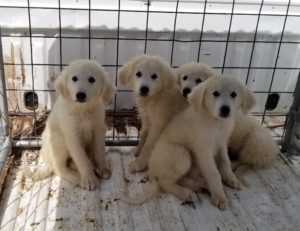
Our newest members of the LGD Bonding Project have arrived! We held a name the puppy contest at the end of August. The winning names were Laverne, Shirley, Lenny and Squiggy. By the time you read this, the four pups will have arrived, and the bonding project will have started. We have added a new phase to the bonding project with two pups being placed in a bonding pen at the Center headquarters to see if dogs bonded in close proximity to buildings, people and vehicles are more likely to roam and seek out those locations vs. dogs bonded away from the headquarters.
The Duke Boys have returned to their owner for further training and bonding. The Legends of Country Music are being moved to their new home in Menard at our research ranch to guard Dorper sheep that have free access to the entire ranch due to a rangeland ecology research study. Only Waylon and Johnny are going, as Willie is being returned to his breeder due to a genetic defect in a front leg. Willie will be guarding livestock on a small piece of property that can provide him the extra care he needs.
LGD Breed Spotlight – Pyrenean Mastiff
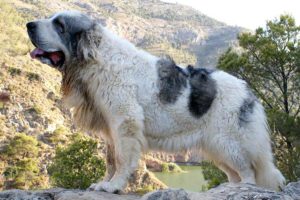
While the origin of the Pyrenean Mastiff is not clearly known, it is generally accepted that the breed is descended from dogs brought from Sumeria and Assyria to Spain by the Phoenicians some 3,000 years ago. Due to the remoteness of the various areas of the Pyrenees Mountains and the rest of the region now known as Spain, the original Molosser dogs developed divergently by region into several livestock guardian breeds. In 1659, France and Spain signed a decree splitting ownership of the Pyrenees Mountains with the northern area becoming French territory, and the Southern area remaining Spanish territory. The French area further refined their mastiff developing a white, longer-haired breed, the Pyrenean Mountain Dog (Great Pyrenees), that possessed a more refined head and stature. The Pyrenean Mountain Dog enjoyed widespread recognition due to its popularity and strong breeding programs, while the Spanish mastiffs in the south continued their work as livestock guardians and remained more massive, primitive, and less homogenous.
In the 1930s and 40s with the disappearance of the wolf and bear from the Pyrenees Mountains, the new reliance on rail to transport sheep, the Spanish Civil War followed by World War II, and a scarcity of food, these noble dogs became almost extinct. With the return of a pack of wolves to the region in the 1970s, there was once again a need for these dogs, now known as the Pyrenean Mastiff. A breeding program was designed by enthusiasts that brought the breed back.
Pyrenean Mastiffs have a dense and moderate in length coat that is bristly in texture. Their hair is usually 2-3 inches in length. Their double coat color is basically white, with a well-defined mask, and sometimes irregularly distributed, clearly outlined patches of body color that match the mask. The most desirable color is snow white with patches of medium grey, intensive golden yellow, brown, black, grey-silver, light beige, sandy or marbled. The dogs mask should be clearly defined. The tip of the tail and the lower parts of the legs are white. They can handle dry heat, but humid climates are uncomfortable for them.
Pyrenean Mastiffs are large dogs starting in height at 28 inches with no upper height limit. They can weigh between 120-240lbs making them one of the larger livestock guardian dog breeds. This large size can lead to a healthy appetite to maintain its body condition. Being extremely large, Pyrenean Mastiffs are excellent fence climbers and need quality fences to keep them confined. Double dew claws are also common in this breed. While relatively rare, the breed has spread throughout the world with somewhere between 4,000 and 6,000 dogs worldwide.
Sources: Dohner, Janet Vorwald. Farm Dogs: A Comprehensive Breed Guide to 93 Guardians, Herders, Terriers, and Other Canine Working Partners. Storey Publishing, 2016, https://www.ukcdogs.com/pyrenean-mastiff , http://pmusa.pyreneanmastiffclubs.org/default.aspx
Breeder Profile
This month’s LGD breeder is Katy Siepert from Hamilton, Texas.
Q: Describe your operation/ranch.
- How many LGDs do you currently own?
- Explain your LGD program.
A: My husband and I have a small operation of around 150 sheep and the same number of goats. We have three dogs that we have owned a while, but also have several pups in training. The older dogs are great for starting the pups, but one new pup is about enough for an adult dog to train. Trudy, my oldest dog, had ten pups this time around. So right now, some of the pups are with the older dogs, but the rest are
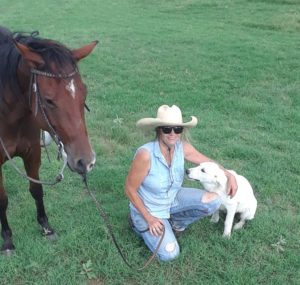
on goats and sheep supervised by me.
At about 8-9 weeks we start teaching them to lead and tie. This makes it easier to watch them and correct them as they are put with goats or sheep. At around 10 weeks they are doing well. They aren’t staying out full time but for several hours. By this time, it’s gotten much easier to keep them out with the herd, and the dogs are concerned about the goats or sheep. This summer was hard because even though these Akbash pups are short haired, they get hot very easily. If I hadn’t had a creek for them to cool off in, I don’t know I would have persuaded them to stay out in that 106-degree heat!
Q: What got you started in breeding LGDs?
A: Town dogs were killing my goats. I didn’t really like dogs and had my doubts. I bought two grown Anatolian/Pyrenees crosses. One of them was unbelievable. They were not like any other dogs I had ever known. Smart to the bone. Unbelievable. She chased my neighbor’s dog back to their house – a no good Heinz variety – but the owners to this no count dog shot my wonderful dog. I never forgot her. I thought she was one of a kind. It turns out these dogs are so much smarter than any other dog. They don’t really “obey” but they do more. They figure out what you want by watching a few seconds and then they help. For example, if you are trying to get goats or sheep across a creek, they walk out in the water, turn around and walk back to the bank so the goats or sheep will follow. I have seen it time after time.

Q: How long have you bred LGDs?
A: I have been raising livestock guardian dogs for about 30 years now.
Q: Do you prefer a specific breed of LGD?
A: Yes, Akbash as they are resilient enough as pups that a strong head butt from a mean mama goat or sheep won’t discourage them from coming back around, yet sensitive enough that they learn quickly to stay away from their babies. Akbash truly love their herd which is essential in protecting them. In the pasture, adult Akbash can be found near the herd under a shade tree or maybe right in the middle of the herd. They don’t venture far.
Q: What breed of LGD do you raise?
A: The Akbash breed is compassionate, protective, and energetic. It’s hard to get all three of these in any other lives

tock guardian dog breed as far I as I am concerned.
Q: What is the one thing you wish you knew before starting to breed LGDs?
A: One of the most important things I have learned and would recommend to a new user of LGDs is to not get too many dogs on a herd of goats or sheep. They like to stay busy and lack of work will lose their interest, especially younger dogs. If you want to keep them working and aren’t sure how many dogs are needed, start with a low number. Equally important is when a young pup comes back to the barn, tie them up! Make it a treat to go out with the herd. Don’t let them become barn dogs! A
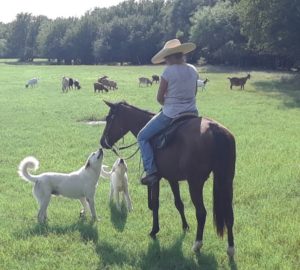
dog that saves their owner money from fewer lost goats or sheep is more appreciated than a dog that lies around at the barn.
Q: What is the number one thing you recommend to a new LGD user?
A: The most important thing I would recommend to a new LGD owner is to give their dog or pup a strategy. At least for a while pen the goats or sheep at evening and feed both the dogs and the sheep at the same time. The sheep will get in the habit of coming in at the same time and the dogs learn to stay with them. If the dogs come in early without the sheep or goats, tie them up, but don’t feed them until the sheep come in. They will learn that they only eat when they are with the goats or sheep.
Q: What is your favorite LGD or LGD story and why?
A: Every situation is different, so each person must design a program for themselves. When the dog understands what his owner wants it all begins to click. Nothing can compare to the comfort in knowing this animal loves your herd as much as you do.
LGD Timely Tips
Every Tuesday check out our Facebook page @TAMUlivestockguardog for Tuesday’s LGD Tip of the Week!
- Purchase collars with ID tags attached to them to make returning your LGD easier if the roam.
- Make sure to ID chip your LGD in case it is lost and taken to a veterinarian or animal shelter. Most cost about $40 which is a low cost to pay to make sure your LGD is returned to you should it be taken by a person rescuing them from the side of the road.
- Use a GPS tracker to easily locate your LGD 24 hours a day. We are currently using the Oyster by Digital Matters.
To provide feedback on this article or request topics for future articles, please contact me at bill.costanzo@ag.tamu.edu or 325-657-7311. The Texas A&M AgriLife Livestock Guardian Dog Program is a cooperative effort by Texas A&M AgriLife Research and the Texas Sheep and Goat Predator Management Board.
Follow us on Facebook: https://www.facebook.com/TAMUlivestockguarddog/
Follow us on Instagram: @tamulivestockguarddog
Follow us on YouTube: https://www.youtube.com/channel/UCF7YbP6bNDV7___6H8mifBA
The Guardian Way – September 2020
Home & Work
The boys and I were busy packing boxes to move to a new house in town at the end of August. We sold our place outside of Grape Creek and moved to a smaller home in San Angelo. This is going to be a big adjustment for the three of us and our two dogs. My registered border collie, Booker, and my Pyrenees Maremma cross, Brutus, have never lived in town. It is important to make changes with your LGDs slowly over time. Things like adding or deleting livestock that the dog is accustomed to may cause behavior problems.
We were busy at the AgriLife Center last month. Our maintenance crew and I installed water lines to all the bonding pens, so I do not have to haul water out to the stock and pups every other day. That is a huge time saver for me. We also removed our old kennel, poured a concrete slab for the new one, and started fabricating the new kennel structure. The project should be done by the middle of September. We also held the annual Sheep & Goat Field Day virtually this year, which included a presentation of the LGD program. Check the Facebook page for more information regarding the LGD Field Day on September 25th in Fredericksburg.
Internal Parasites – Gastrointestinal
This is the second part of a multi-part series on canine gastrointestinal parasites. The most common type of internal parasites that an owner of LGDs will encounter are worms. There are five main types of worms that your LGD may encounter: roundworms, hookworms, whipworms, tapeworms and flukes. Last month we covered hookworms and this month we will focus on whipworms in LGDs.
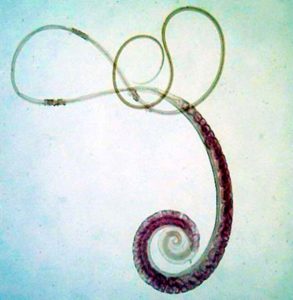
The whipworm parasite is generally transmitted to dogs when they ingest infested food or water. Although whipworms can be contracted from other infected animals as well. Adult whipworms in dogs are typically found in the colon and cecum which is a part of the large intestine. They attach themselves firmly to the intestinal wall. Eggs are passed in the feces and become infective in about 4 to 8 weeks. Under ideal conditions, whipworm eggs can remain dormant in the environment for several years in moist climates. Once infective eggs are ingested by the host, the larvae hatch and develop in the small intestine and then move to the cecum and colon, where the adults mature in about 11 weeks and will remain there for up to 16 months. No signs are seen in light infections, but as the number of worms increases the cecum and colon can become inflamed, which can cause diarrhea and weight loss in the dog. Fresh blood might be seen in the feces in heavy infections and anemia may also result.
Since whipworm eggs take a month to become infective, whipworms can be controlled with good sanitation in a kennel situation. Prompt removal and proper disposal of feces is critical in confined areas. Whipworms are susceptible to drying; therefore, keeping the dog in an environment that is clean and dry reduces the risk of infection considerably. A variety of medications—including some monthly drugs that prevent infections with other parasites like heartworms—are available for treating whipworm infections. Your veterinarian will choose one that is appropriate for your LGD and its environment.
Sources: https://www.merckvetmanual.com/dog-owners/digestive-disorders-of-dogs/gastrointestinal-parasites-of-dogs?query=canine%20internal%20parasites#v3202812, https://www.merckvetmanual.com/digestive-system/gastrointestinal-parasites-of-small-animals/whipworms-in-small-animals?query=canine%20whipworms, https://www.petmd.com/dog/conditions/infectious-parasitic/c_multi_trichuriasis
LGD Puppy Bonding Project
We will be starting our second round of the Bonding Project Trial this month. We have added a new phase to the project, and we will have a total of eight dogs involved this time from two different breeders in Texas. We will be bonding two of the dogs within close proximity to our Center and the others will be bonded in a pen at the furthest end of our pastures, over 1 mile away. The goal of this project is to see if there is a difference in roaming behavior later in life of dogs bonded to animals nearer to human activity than dogs bonded further away.

The Duke Boys that are being trained for a cooperating producer are coming along well. They will be leaving once the new set of puppies arrive for the Bonding Project. The Legends of Country Music are also doing well and will be moving to our research ranch in Menard at the end of September. They will 8 months old by that time and ready to start working under the supervision of our two adult dogs with the sheep there. Willie will be returned to his breeder as his right front leg is still causing him to limp and move around slowly. He will have a small place to guard and receive the daily care he needs. I will miss his friendly and happy personality.
The Stooges are all still doing well at the cooperating producers ranch. The hot wire treatment during bonding has worked very well for those dogs. According to the producer they are always with stock and have not left the herd at all. GPS data for over 60 days shows that he is correct about that.
The Superheroes are also doing well, but Thor and Hulk routinely leave their pastures to guard other stock. Thor also visits his old friends, the Stooges, once in a while. In their defense, the fencing at that ranch is old and holes develop regularly which does not help keep the dogs and stock where they are supposed to be. However, it does show a difference in the bonding project criteria since these dogs did not have hot wire in their pens when they were reared and bonded at the Center.
LGD Breed Spotlight – Karakachan
The Karakachan dog is likely a breed you have not heard much about as they are rare in the United States. Native to Bulgaria, it is difficult to trace their exact
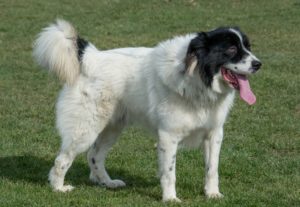
origin as they are an ancient breed. It is widely believed that they originated from Central Asian herding dogs. They derive their name from a native group of shepherding people called the Karakachani, who lived in Greece, Bulgaria, and Albania. These nomadic people put great emphasis on animal breeding, as well as preserving, the Karakachan dog.
The dog breed’s prime purpose has always been to guard livestock on mountains. They are known for their courage when confronted with such threatening predators, like bears and wolves, and will not hesitate to defend their flock. Due to their sheer size, as well as their inherent loyalty and territorial behavior, the Karakachan has also been used for many years as a patrol dog.
The Karakachan is a remarkably large and impressive dog, reaching heights of 25-30 inches, weighing between 88-135lbs. They are double coated and always have a thick, full undercoat, but their straight topcoat is variable among the breed and may be short or long. When long, it should reach lengths of over 4 inches. Their coat color will be white with brown, or white with black, or white with both black and brown. Large, well defined colored spots are preferred on the dogs. Most dogs have black noses, but red noses are seen in red or brown dogs.
The Karakachan is dedicated to its role and is hardy, diligent, and hard-working. They are always alert, patrolling and guarding their flock. They will bark to warn off predators. They are less likely to roam than other LGD breeds and will move their stock to safe areas if they perceive a threat. Any perceived threat to their herd will be met with aggression. They are a breed that will bond closely with their stock and will quickly become very protective of them. They need extensive socialization when young to encourage them to be tolerant of strangers within their area, as they will instinctively be very wary of any newcomer.
They were developed throughout the years for high levels of stamina and the ability to patrol a flock all day and jump to their defense when needed. While they are known to be an intelligent breed, the Karakachan survived by itself for a long time out on the remote Bulgarian mountains and can thus be strong-willed when it comes to training. They require a confident and experienced handler who will not allow them to get their own way. This is particularly important due to their strength and potential for aggression when they feel threatened. Positive reinforcement works best when training the Karakachan.
Sources: Dohner, Janet Vorwald. Farm Dogs: A Comprehensive Breed Guide to 93 Guardians, Herders, Terriers, and Other Canine Working Partners. Storey Publishing, 2016, https://www.dogzone.com/breeds/karakachan/ , http://www.karakachanusa.org/
Breeder Profile
This month’s LGD breeder who is using LGDs in his operation is Michael Annuziato from South Plains, Texas . He owns and operates the A Bar Z Ranch.
Q: Describe your operation/ranch.
- How many LGDs do you currently own?
- Explain your LGD program.
A: We have a small breeding operation of sheep, goats, alpacas, chickens, ducks, turkeys, quarter horses and cattle. We have six adult LGDs and four pups that
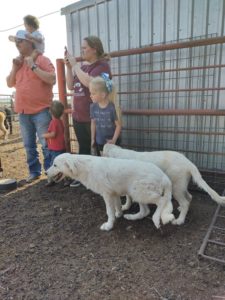
are 5 months old. There are currently dogs with different animals and at different locations, usually in pastures of two to three dogs guarding.
Q: What got you started in breeding LGDs?
A: We had two old Maremmas that were extremely good guardians that died on our property. We had a difficult time replacing them. I was working for a neighbor taking care of his sheep when he suggested that I breed and raise some for him and sell the rest.
Q:How long have you bred LGDs?
A: I have been breeding and selling livestock guardian dogs for seven years now.
Q: Do you prefer a specific breed of LGD?
A: Yes, I prefer Maremmas. They are originally from Italy. They seem to stay with livestock better than other breeds I have used.
Q:What breed of LGD do you raise?
A: I raise purebred Maremmas. I feel purebreds do better than mixing breeds to form composites. You do not always end up with the best of the breeds in pups when you mix them together. There is not enough scientific information available on purebred LGDs, let alone mixed breeds of dogs to know what traits are likely to show up in a specific breeding cross.
Q: Do you have an LGD mentor?
A: My mentors have all moved on, but they were there to help me start 15 years ago. I’m always available to my customers to answer questions and provide advice on the dogs. Its important to have a mentor to talk to when you are just starting out with the dogs. You breeder is a great choice since they know their specific line of LGDs.
Q: What is the one thing you wish you knew before starting to breed LGDs?
A: The special thing I did in the beginning was to research the breed and find out all I could about them. I would highly recommend that people that are looking into getting livestock guardian dogs do as much research as possible on the dogs. They should look for a breeder that raises the breed of dog that they are wanting. They want to make sure that the breeder bonds the dogs to the same type of livestock that the producer has at his ranch
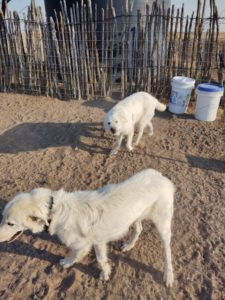
Q: What is the number one thing you would recommend to a new LGD user?
A: I would highly recommend that people that are looking into getting livestock guardian dogs do as much research as possible on the dogs. They should look for a breeder that raises the breed of dog that they are wanting. They want to make sure that the breeder bonds the dogs to the same type of livestock that the producer has at his ranch.
Q: What is the number one thing you recommend to a new LGD user?
A: Do research on the LGDs. Interact with other LGD owners, find a right-hand man that will be very loyal and help you.
Q: What is your favorite LGD or LGD story and why?
A: The Maremma is my favorite, very loyal, and passionate about their job. They tend to stay with the stock, bonding and protecting them. They are not an overly aggressive LGD. They have a large deep bark that warns the enemy to stay away. They can be, and I recommend it that they be, socialized with family. This also helps when you must take them to the vet for shots etc. They are highly intelligent! They are very loving and gentle with our children and grandchildren.
LGD Timely Tips
Every Tuesday check out our Facebook page @TAMUlivestockguardog for Tuesday’s LGD Tip of the Week!
- Dogs heavily infested with brown dog ticks often require blood transfusions to recover. Routine use of tick control keeps the situation from getting out of paw
- Hepatozoonosis is a tick-borne disease that can cause weight loss, fever, lethargy, and muscle pain. Transmission of Hepatozoonosis occurs by ingestion of an infected tick and not by a tick bite.
- You may not always spot a tapeworm in pet’s feces after treatment, but this does not mean the pet was not infected. The treatment targets the tegument or covering of the worm, which may cause it to be digested by the animal instead.
Sources: Bayer Animal Health Companion Vector Borne Diseases Calendar 2019
To provide feedback on this article or request topics for future articles, please contact me at bill.costanzo@ag.tamu.edu or 325-657-7311.
Follow us on Facebook: https://www.facebook.com/TAMUlivestockguarddog/
Follow us on YouTube: https://www.youtube.com/channel/UCF7YbP6bNDV7___6H8mifBA
The Guardian Way – August 2020
Home & Work
My boys are finally registered for their college courses after more than two months of delays due to Covid-19 closures and will be starting classes at the end of the month. That was quite an ordeal to go through with limited personal interaction due to the lockdown. Hopefully no one has been too inconvenienced trying to contact personnel at the San Angelo AgriLife Center; we are back working at 50% capacity at our location until further notice.
We are gearing up for the next phase of the puppy bonding project in early fall. We are currently looking for puppies to place into our second trial. Check our Facebook page for the name the puppy contest.
We were happy to have Dr. John Tomecek join us for the July webinar on the LGDs and wildlife. Dr. Tomecek is an Assistant Professor and Extension Wildlife Specialist and was based out of the San Angelo Center a few years ago, but is now based out of Thrall, Texas. https://www.youtube.com/watch?v=uExmgKerf8A&t=25s
We are now hosting monthly LGD webinars. Each event will be sponsored, and prizes provided by the sponsors may be given away to lucky participants. Each webinar will be on a different topic related to livestock guardian dogs. Check out our Facebook page @TAMUlivestockguarddog for more details and to register for the events. Don’t forget to follow our YouTube channel at https://www.youtube.com/channel/UCF7YbP6bNDV7___6H8mifBA
Internal Parasites – Gastrointestinal
This is the second part of a multi-part series on canine gastrointestinal parasites. The most common type of internal parasites that an owner of LGDs will encounter are worms. There are five main types of worms that your LGD may encounter: roundworms, hookworms, whipworms, tapeworms and flukes. Last month we covered round worms and this month we will focus on hookworms in LGDs.
There are several types of hookworms that can cause disease in dogs. Ancylostoma braziliense infects dogs and is distributed from Florida to North Carolina and along the Gulf Coast in the United States. Uncinaria stenocephala is the principal canine hookworm in cooler regions. It is the primary canine hookworm in the northern fringe of the United States, but it is found with frequency across the country.
Hookworm eggs are first passed in a dog’s feces 15 to 20 days after they are infected. They hatch in 1 to 3 days when deposited on warm, moist soil. Transmission of the worms may result when larvae are ingested or in the case of A. caninum, from the colostrum or milk of infected female dogs. Infections with Ancylostoma species can also result from larval invasion through the skin. Once the skin is penetrated in young pups the worm’s larvae migrate through the blood to the dog’s lungs. The worms are then coughed up and swallowed to mature in the dog’s small intestine. However, in dogs more than 3 months old the larvae may remain in the body tissues in a state of arrested development. These larvae are activated after removal of adult worms from the intestine or during pregnancy. They will then accumulate in the small intestine or mammary glands of the female dog.
A hookworm infection will often cause anemia in young puppies and it may be fatal. The anemia is the result of the bloodsucking and the bleeding internal wounds that occur when these hookworms change their internal feeding sites in the small intestine. This movement of the worms leaves open wounds in the dog’s intestines. An outward sign of infection to look for is pale linings of the dog’s nostrils, lips and ears. Surviving puppies develop some immunity and show less severe signs. Malnourished and weakened animals may continue to grow poorly and suffer from long-term anemia. Mature dogs may harbor a few worms without showing signs. These dogs are often the direct or indirect source of infection for puppies. Watch for diarrhea with dark, tarry feces as this is a sign of severe infections in dogs. Anemia, loss of appetite, weight loss and weakness develop in long term cases of the disease.
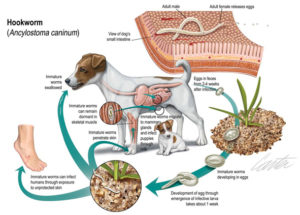
There are several drugs and drug combinations that are approved for treatment of hookworm infections in dogs. In addition, many heartworm medications also control certain species of hookworms. Hookworms cannot be seen with the naked eyes. A diagnosis can often be made from the identification of hookworm eggs upon microscopic examination of fresh feces from infected dogs. Your veterinarian can recommend the best treatment for your LGDs if you suspect a hookworm infection.
Sources: https://www.merckvetmanual.com/dog-owners/digestive-disorders-of-dogs/gastrointestinal-parasites-of-dogs?query=canine%20internal%20parasites#v3202812, https://www.petmd.com/dog/conditions/infectious-parasitic/c_multi_ancylostomiasis
LGD Puppy Bonding Project
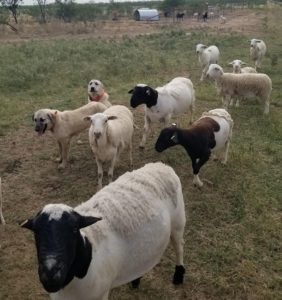
The Legends of Country Music are now over 6 months old and are all doing well. Waylon’s injuries are all healed up at this point and he is very happy to have rejoined Johnny. Willie had an issue with a front leg. For some reason the growth plate in his knee has fused together already. This in turn caused him to limp which irritated the should and wrist joints. Our veterinarian is not sure why this occurred, as it was only the one growth plate. Willie was prescribed limited movement for three weeks along with an anti-inflammatory medication and a pain medication. He is doing much better now and recently rejoined his brothers. If the problem should return, he will have to be removed from the program as our veterinarian feels he will not be able to effectively carry out his duties on large acreage. We will keep you updated on Willie if the problem reoccurs.
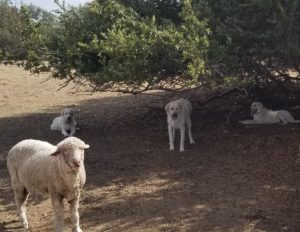
The Superhero’s are all doing well still and getting big! I almost didn’t recognize them the last time I saw them. Thor has wandered twice recently to visit his old friends the Stooges at a cooperating producers ranch. We are trying out a new satellite GPS tracker on the dogs from Optimus Tracking. The trackers are working great and we are getting regular updates on their positions.
These new satellite trackers use 4 AAA batteries and are waterproof. They don’t require cellular service which is a big plus for our ranch location. The company claims that the unit’s batteries should last 6 months so it will be interesting to find out in a real-world application. We will keep you posted how they are working.
LGD Breed Spotlight – Sarplaninac
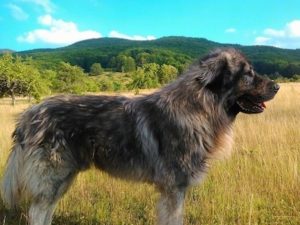
The Sarplaninac (pronounced shar-pla-nee-natz) is from the mountain region of southeastern Yugoslavia (now Serbia), Macedonia, Kosovo and Albania. This breed was formerly named the Illyrian Shepherd Dog when first recognized in 1939. The name was changed in 1957 to Yugoslavian Shepherd Dog Sharplanina, after the Sharplanina mountain range where the breed is most common. The Sarplaninac is still widely used in its homeland to protect flocks against predators. Until 1970, Sarplaninac’s could not be legally exported from Yugoslavia. Since then, growing numbers of American ranchers have been successfully using Sarplaninac’s for predator control. They prefer more human contact than other breeds which make them slightly less suitable for range operations.
The Sarplaninac is a formidable adversary of predatory animals. This breed has a typical livestock guarding temperament: highly intelligent and independent; devoted to family members and wary of strangers. It is calm and steady but fearless and quick to react to perceived threats. The Sarplaninac is a medium-sized dog who looks bigger than they are because of their heavy bone and thick coats. The length of the dog’s body is slightly longer than its height and the head is in proportion to the size of the body. The Sarplaninac’s ears are drop and V-shaped.
The Sarplaninac is a double-coated breed with a long, straight, rough-textured outer coat and a shorter, much finer and thicker undercoat. The coat on the head, ears, and front side of the legs is short. The hair on the neck, buttocks, tail and the back side of the legs is longer. This variation in coat length results in a ruff at the neck, and frill on the buttocks and backs of the legs.
The dog’s height at maturity is 24 inches or more for males and 22½ inches or more for females. Mature males in good working condition weigh between 77 and 99 pounds. While mature females weigh between 66 and 88 pounds. Despite being slightly smaller than many other livestock guarding breeds, the Sarplaninac is characterized by extraordinary strength. Dogs in North America tend to be slightly larger than their European counterparts. Our producer of the month, Independence Wool, uses these dogs on their livestock operation. Check out what they have to say towards the end of this month’s edition of The Guardian Way!
Sources: Dohner, Janet Vorwald. Farm Dogs: A Comprehensive Breed Guide to 93 Guardians, Herders, Terriers, and Other Canine Working Partners. Storey Publishing, 2016, https://www.ukcdogs.com/sarplaninac
Texas LGD Association
In the fall of 2019 several LGD breeders where contacted by the AgriLife Center in San Angelo in the hopes of establishing an association to support the use of livestock guardian dogs in Texas. The group of local breeders has met several times and have officially formed the Texas Livestock Guardian Dog Association. The goal of the organization is to support, promote and advance the sustainable use of effective livestock guardian dogs by farmers and ranchers. The group of 16 founding members represents a variety of LGD breeders, ranchers and people interested in promoting LGD use in Texas. Bylaws for the association have been created and a temporary board of directors has been selected. The organization is officially recognized by the State of Texas and is in the process of filing a 501c3 nonprofit request with the IRS.
The TLGDA has a Facebook page that can be found @TexasLGDAssociation. One of the main goals is to create a website for breeders to advertise LGDs for sale and to promote the use of the dogs to ranchers. The group will be making a presentation at the AgriLife LGD Field Day in Fredericksburg on September 25. The association is open to anyone that is interested in raising, using or promoting the use of LGDs. Please contact me via email at bill.costanzo@ag.tamu.edu with any questions or how to join the Texas Livestock Guardian Dog Association.
Breeder Profile
This month’s LGD ranchers that is effectively using LGDs in their operation are Dawn and Paul Brown of Independence Wool.
Q: Describe your operation/ranch.
- What type of livestock do you have?
- How many head of stock do your dog’s guard?
- How many acres do your dog’s guard?
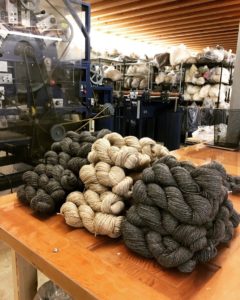
A: We are a small sheep and goat ranch located outside of Independence, Texas, between Brenham and College Station. Our home, ranch, and wool mill sit on 80 acres in an area of low rolling hills, live oaks, scattered brush and native prairie grasses. Our range, combined with usual plentiful rainfall, allow for a denser stocking rate which currently consists of 120 Angora goats and fine wool sheep (Rambouillet and Merino). We primarily produce wool and mohair as a source of fiber for the mill, although we purchase raw fiber from other Texas producers as well. We create Texas grown and processed yarn and textiles for the artisan hand-craft market. Our region mostly consists of cattle and horse ranches, and, as it is relatively close to large urban communities, we have mostly part-time weekend-only neighbors. Very little predator control is undertaken in our county, and our biggest issues really surround a hefty coyote population and prevalent town dogs or feral dogs. We do have bobcat, great horned owls, caracara and turkey vultures, but thankfully very few feral hogs. We do have venomous snakes, but mostly copperheads, occasional coral snakes and water moccasins.
Q: How long have you used LGDs?
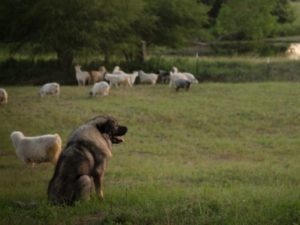
A: We have had LGDs now for almost 10 years. However, Paul has been a dog person since youth, training, competing, and hunting with Labrador retrievers. Growing up, I was always surrounded by dogs and, as a youth, I participated in conformation dog shows with 13-inch beagles. Sporting and hound dogs are very different than the LGD, but you certainly learn a lot about drive, instinct and training from those breeds. With my beagles, they were easily trained and groomed for the show ring, but after you cleaned them all up, if you happened to walk them on the leash past a certain smell, they would drop and roll in it every time!
Q: How many dogs do you use?
A: We usually have four dogs- two with the wethers/bucks, and two with the does/ewes and their kids/lambs. We have two GP females, and one Sarplaninac male. This June we lost our six-year-old Sarplaninac female to Acute Lymphocytic Leukemia. We are fortunate that all the dogs got along very well, three were spayed females, and one is an intact male. The groups of two dogs always shared a fence line with each other, could easily switch partners, and all four worked together in the same pasture if need be. Our two female GPs are litter mates and came to our ranch at 10 weeks of age. They came from working parents and were raised with our goats. Raising sibling females is
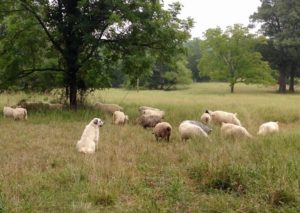
controversial in the LGD world, but it worked great for us. They are matched in energy, independence, guarding style, stock bonding, and lack food/resource aggression… most of all, no fighting between themselves or the other two dogs. They are now 9 years old, and still work together. We were told via the online LGD forums that we “just got lucky” … perhaps… but I believe there is a missing “link” to this issue. Our Sarplaninac’s were imported from Canada, from Grazerie Ranch, Louise Liebenberg. We were looking for a steadfast, loyal guardian with a harder edge in dealing with the coyote load in Texas. Our male dog was 3 years old when imported, and the female was 11 weeks of age. These two dogs shared the same sire, so they were not to be a breeding pair. We spayed the female and left the adult male intact. These dogs are not common in North America, and we thought a litter sired by him could be possible one day down the road.
Q: Do you prefer a specific breed of LGD?
A: I wouldn’t say one breed is preferred over the other, but what we needed were dogs that could be trusted to guard and be companionable as well. As a small ranch and producer, our stock is handled or managed daily in a manner more intensively than a large thousand-plus acre operation. We spend a lot of time around the livestock and dogs, so we sought breeds and breeders that bonded well to their shepherd and flock/herd. I would say our GPs are fairly typical. They bark and posture at threats, move goats off the fence line when they sense danger, putting themselves between the goats and whatever has caused the alarm. They tend to stay in amongst the sheep and goats. They are less aloof than the Sarplaninac and enjoy a great deal more head petting. Overall, the Sars are a harder dog. They are “guardy” and can be a whole lot of dog for one to handle. It is a primitive breed, very old, if not one of the oldest LGD breeds. Having said that, our older male dog, Shadow, is friendly, polite with strangers, incredibly stable and calm, but always on the watch. He was raised in Canada with sheep and seems to prefer their company. Our female Sars that we lost in June was always a handful. She was the most vigilant and reactive of the dogs and would go right through or shimmy under a fence to get at a threat. She was always on the higher-energy side. She required a yoke when in the pasture most all her life. We stopped her as an adolescent from pulling Angora goats around by the tail and dealt with her food aggression. She went on to never hassle or injure stock. She was the best at coming to you when her name was called, and she never picked fights with the other dogs- after she grew out of continuously ankle-biting them as a puppy. It wasn’t always sunshine and roses with her, but she was a good dog and we learned a great deal. Both breeds of our dogs have a denser coat that requires extra care. The Sars have a correct working coat, and thankfully due to our milder winters produce less of a downy undercoat. We do have to manage for spear grass in our area, and feel it is best to clip the belly and leg hair for the dogs. We also clip the hair under their ears in the summer as it seems to help them stay cool and have fewer ear ailments.
Q: Do you have an LGD mentor?
A: Someone I have enjoyed following over the years is Louise Liebenberg of Predator Friendly Ranching Blog, High Prairie, Alberta. We imported our two Sarplaninac’s from her in 2014. While her range is vastly different than ours, I felt that her methods were generally based on the idea that by making management decisions that set your dog’s up for success, many problems can be avoided and therefore the rancher, dogs, wildlife and livestock all benefit. This goes for just about everything, deciding how the dogs are fed to reduce the chances of food aggression, what fencing type and height to decrease roaming, GPS and identifying collars for location if dogs wander, socialization and basic obedience training to promote a safe “good citizen” guardian at the ranch or if in contact with the public. Louise also implements nighttime corralling with her stock and dogs, and that is something that works well for us, too. Our sheep and goats, along with the dogs, come back to shelter in the evenings. This paddock is enclosed behind a gate overnight. In the morning, chores are finished, and everyone is turned back out to their pastures.
Q: What’s the one thing you wish you knew before starting to use LGDs?
A: I would have to say when doing research regarding LGDs and their management, be wary of individuals that offer knowledge or advice in absolutes. Language such as “must always”, “don’t ever”, and “must not” when dealing with working dogs doesn’t agree with me. The varied range conditions, operations sizes, type of stock guarded, and breed characteristics, make it hard for a “one size fits all” absolute approach. Starting down that path early into LGDs can set you up for disappointment and discourage you from finding what really works for your ranch.
Q: What is the biggest thing you recommend to a new LGD user?
A: Consider treating the dogs like the valuable asset to your ranch that they really are. Treat them well and set them up for success. Give
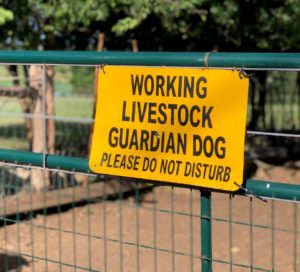
them fewer obstacles to an already tough job. Provide them good food, clean water, quality vet care, correct fences. Give them a way to get back to you if they get lost chasing a predator- microchip, GPS collar, collar with tags. Depending on your area- let your neighbors know what to expect from your dogs, educate them about the dog’s job and value to livestock and wildlife. Reinforce the dog’s good behavior, have positive energy, smile and be kind. If you feel like throwing things, screaming, and punching a wall, and that can happen with LGDs, try not to scream and throw things at them. If something goes wrong, take a step back, see if you had a role in the outcome before claiming the dog failed. No one is perfect, no dog is perfect, but a good LGD is worth all the effort.
Q: What is your favorite LGD or LGD story and why?
A: Paul’s favorite story: Angora goats, and goats in general, can easily get themselves into predicaments. One evening in early fall, one of our yearling bucks in full fleece found himself stuck in bramble vines and unable to get free. When the herd headed off to the barn before dark, he was left behind and struggling to get free. One thing that is handy when nighttime corralling our animals, is that you notice when all the dogs are not back at the barn at dusk, sometimes that is easier than counting all the goats. And on this night, one of the GPs didn’t return with her goats. Paul went out to search for her and found the buck in the brambles with the dog standing by. Good dog.
Dawn’s favorite story: My story has to do with an unexpected visitor in the barn. When we first started raising Angora goats in 2010, my job had taken us from Texas to Northeast Arkansas. I was practicing rural women’s health out in the foothills of the Ozarks, near the Missouri border. In addition to the goats, we also raised black Angus seedstock via AI. One afternoon during a torrential rainstorm, I was working in the office area of the barn and had the dogs inside with me. Our goats were like indoor cats and never liked to be wet, so they were bedded down undercover during the storm. The rain was so heavy on the metal roof that I didn’t hear anyone approaching barn, but when the door opened and a hooded raincoat clad man entered with the liquid nitrogen for the cryo tank- the dogs were up and barking angrily- I call it the vicious “police dog” bark. He backed out fast!
LGD Timely Tips
Every Tuesday check out our Facebook page @TAMUlivestockguardog for Tuesday’s LGD Tip of the Week!
- Ticks don’t engorge within 24 hours. If you see an engorged tick it means it has been there for longer. The feeding period can range

Engorged Brown Dog Tick & normal Brown Dog Tick from several days to more than a week.
- The brown dog tick is the perfect vector for several dangerous pathogens including Ehrlichia canis and Babesia vogeli.
- Heartworm microfilariae can be transmitted to unborn puppies via the placenta. So,
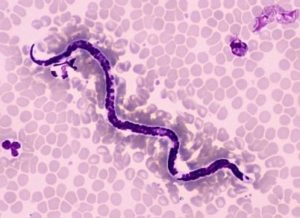
Heart Worm Microfilariae puppies may be born with microfilariae in their circulatory system!
To provide feedback on this article or request topics for future articles, please contact me at bill.costanzo@ag.tamu.edu or 325-657-7311.
Bill Costanzo
Research Specialist II, Livestock Guardian Dogs
Follow us on Facebook: https://www.facebook.com/TAMUlivestockguarddog/
Follow us on YouTube: https://www.youtube.com/channel/UCF7YbP6bNDV7___6H8mifBA



